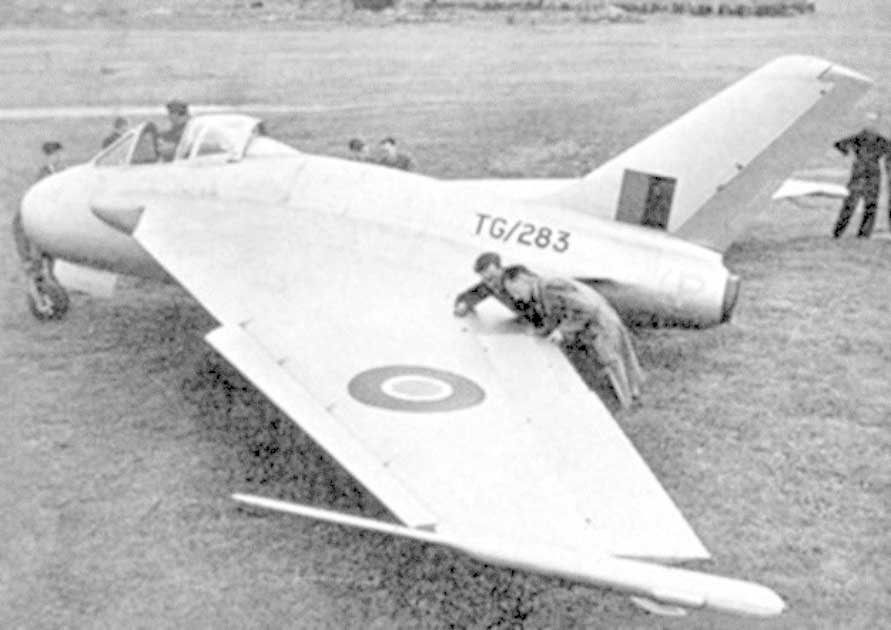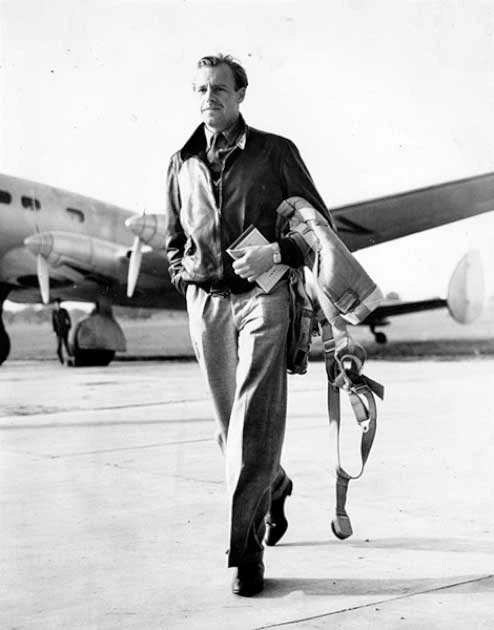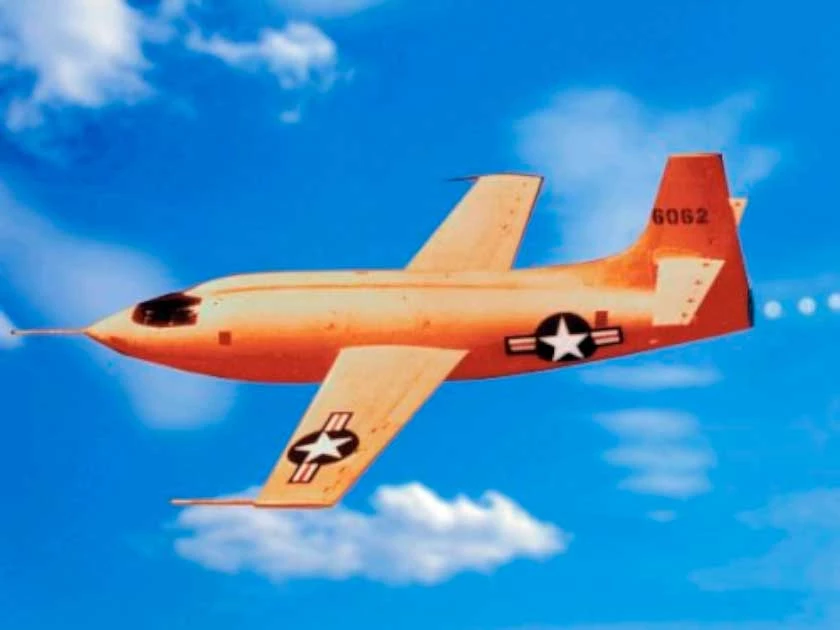In 1944, with the Second World War having turned decisively in favor of the Allies, for the first time in years the world could focus on what would happen afterwards. Many civilian industries, particularly those on the winning side, were rushing to find new uses for the inventions and discoveries that had come from the great conflict.
For the aviation industry there was only one game in town: this was the dawn of the jet era. The new engines and the power they provided transformed the world of aircraft forever, allowing them to fly higher and faster as they approached that mythical line in the sky: the sound barrier.
Officially, the sound barrier was first broken by United States test pilot Charles “Chuck” Yeager on October 14 1947. But this is the story of how the British almost got there first, and what happened to the craft that tried. This is the story of the “killer” de Havilland Swallow.
The De Havilland DH 108
There have been many aircraft designed with a single purpose, and this is certainly true of the de Havilland Swallow airplane, which was designed to fly high and fast, to evaluate handling and performance with a swept wing design. While most aviation planes developed at that time were for military operations, the Swallow, as the de Havilland was nicknamed, was developed for supersonic experiments and research purposes.
Designed with sweptback wings which allowed for faster speed at the expense of handling and agility, only three would be built. However their contribution to supersonic research cannot be overestimated.
The de Havilland DH 108 had other offshoot benefits than simple raw speed, however, and was developed in line with the de Havilland DH 106, known as the “Comet”. The Comet Jet Passenger airline program was actually the predecessor to the de Havilland DH 108 Swallow airplane, and both projects learned from each other.

The DH 108 itself was a very tricky plane to fly because of its design and focus on speed. With a large delta wing which swept back beyond the tail of the small fuselage and no horizontal stabilizers on the tailplane, it looked it echoed the Nazi “Komet”, the suicidal rocket powered interceptor of the late war.
To build it, de Havilland had also turned to a design of one of their latest, greatest designs. They cannibalized the English Electric Vampire, a fighter jet also in development, for much of the forward section of the fuselage including the cockpit.
The result was a beautiful plane that looked fast even when standing still, with the steep rake to the wings and the smooth, silver bodywork. But make no mistake, this was an aircraft on the edge of what was possible at the time, and to fly it de Havilland needed someone of exceptional skill and bravery.
They needed the de Havilland heir: Geoffrey de Havilland Jr.
The Two de Havillands
Geoffrey de Havilland was the owner and chief designer for the de Havilland aircraft company, but in 1946 he was over 60 and could not hope to effectively test his own designs. Into the breach stepped his son, Geoffrey Jr. Born into a life of experimental aircraft, the de Havilland heir had earned his pilot’s license aged 19 and flown aircraft around the world.
De Havilland’s chief test pilot since the age of 27, he had taken up the lead aircraft of every new design for almost a decade when he came to the Swallow, including the legendary Mosquito. He also flew Britain’s first jet powered aircraft, the Gloster Meteor.
Most recently, he had been involved in the development of the Vampire, and so was very familiar with the cockpit and controls of the Swallow. However this new jet aircraft, as it joined the race to fly faster than sound, was to prove very different.
Did de Havilland Jr Break the Sound Barrier?
With such a radical and new design, all characteristics and behaviors of the Swallow needed to be assessed almost from scratch. How did it behave at extremely fast speeds, or at high altitude. How did it handle when taking off or landing, or at slow speeds near the ground?
It was on one such evaluation flight that Geoffrey de Havilland Jr took prototype TG306 up over the Thames estuary to the east of London on 27 September 1946. This was the second prototype, and the first with true high speed capability: the first had been more of a testbed for the various control surfaces and overall design of the aircraft.
This swallow was powered by a de Havilland Goblin 3 turbojet. Only the second jet engine ever developed by the British, this was a radical improvement over the first and gave the Swallow a frightening amount of power and thrust.

De Havilland took the Swallow up that day to evaluate how she handled at high speed. He launched the silver dart up and over the river, turning in a lazy loop as he climbed before tipping her over into a dive as he returned to the aerodrome. As he flew towards the ground he opened the throttles and picked up speed.
The aircraft is known to have been able to fly faster than Mach 0.9 (90% of the speed of sound) and that was certainly at least as the Swallow was going in that dive. However on that day the stresses placed on the airframe by the dive and speed were too great: the pressure of air from the nose of the aircraft forced the nose down and the additional stresses tore the wings backward. The Swallow plunged to the ground and Geoffrey was killed.
- The Largest Aircraft in WW2: What happened to the “Gigant”?
- What Happened to Star Dust? The Plane Taken by the Andes
Did Geoffrey de Havilland break the sound barrier that day? Many in the industry believed that he might have, and it was certainly the trans-sonic buffeting that destroyed his aircraft. However it would be more than another year and half a world away before the sound barrier was definitively broken, this time for good.
Life After Geoffrey De Havilland
One more prototype was flown after the tragedy of that day, designated the VW 120 and with additional improvements. The VW120 was designed to resolve the issues and difficulties that the TG 306 faced.
The first flight of the VW 120 was on July 24, 1947, almost a year after the crash. The plane had an improved cockpit and ejection seat so that the pilot could escape safely from the plane before it crashed. Additionally, the plane was strengthened with the help of modifications so that the previous issues in flight would not arise.
The wing surfaces were now power-assisted, and the engine was also modified to reduce pilot fatigue and increase flight speed. The controls were also modified so that the pilot would more easily remain in control and fly safely.
The VW120 model went on to become the most famous De Havilland DH 108 as it was thought to have indeed broken the sound barrier on September 6, 1948. The official speed of the aircraft at this time, when the plane was in a steep dive, was Mach 1.02.

During this steep dive, the pilot lost control of the aircraft briefly but managed to reclaim it. Geoffrey de Havilland had been vindicated however: the Swallow, dangerous as it was, could achieve the impossible.
Tragedy struck two years later though, in February 1950, when the plane disintegrated in flight and was lost, once again killing its pilot. Ironically, this last crash is thought to have nothing to do with the plane itself, but was rather due to pilot incapacitation due to lack of oxygen.
After this, the Swallow program was never resurrected. The De Havilland DH 108 will always be remembered however, for her radical design, for her speed, and for the men she killed.
And, just maybe, for being the first plane to fly faster than the speed of sound.
Top Image: Beautiful but deadly: the de Havilland Swallow. Source: SDASM Archives / Public Domain.
By Bipin Dimri